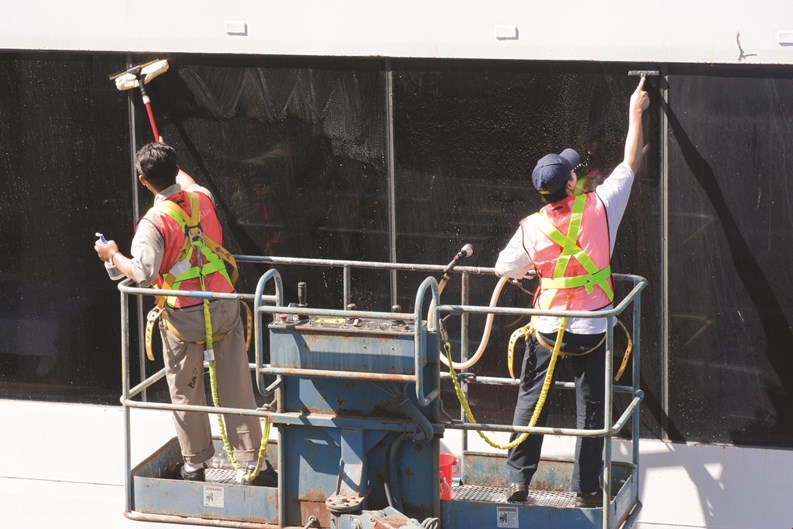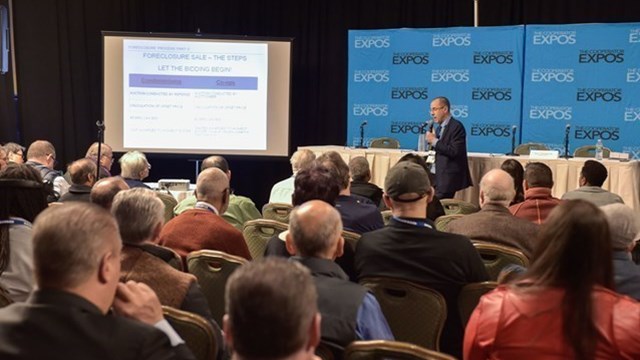When your building or association is faced with an exterior maintenance or repair job, it’s important that you don’t just hire the first contractor who comes along; carrying out your due diligence can make the difference between working cooperatively with a contractor to get the project completed on time and on budget, or winding up with partial or poorly-done work and a mess of legal problems after the fact.
Contractor Credentials
Exterior contractors are a breed all their own. Those who specialize in masonry, painting, paving, heck, even the big dogs like architects and engineers, need certain qualifications in order to perform their work competently. A condominium or homeowners’ association board depends on these professionals, and cannot go into any project, half-cocked, without fear of betraying its fiduciary duty to ownership. This means that boards need to solicit multiple bids from vendors, thoroughly vet contenders before hiring, and stay on top of every aspect of a project as it progresses, lest something go awry. How does a board do this, exactly? Well, that’s what we intend to find out.
The credentials for exterior contractors differ from those required of interior contractors are primarily related to licenses, experience level, insurance capacity and a demonstrated safety program.
“The higher risks associated with exterior work naturally demands a higher level of scrutiny than simply accepting the lowest bid in response to a request for proposal for installing drywall or painting,” says Tim Hegarty, a partner with the Manhattan-based construction law firm Zetlin & De Chiara LLP. “Much like a surety that underwrites bonds for contractors, a wise board will desire and demand a proven track record with an exemplary focus on safety from exterior contractors in their particular area of expertise. In other words, a low-bid process is not the best way to select exterior contractors. Rather, qualification-based selection is more prudent.”
Desiree Pilgrim-Hunter of DPH Consulting Group in the Bronx has spent eight years as the president of the Fordham Hill Owners Corporation, the largest privately financed co-op in the Bronx. Over that time, she has worked with numerous contractors in her role as representative the board and building.
“The board members must first familiarize themselves with the licensing and documentation required of the contractors being considered for the specific project in question; then we review the liability insurance for the corporation,” she says. “If a board member is personally involved with a contractor requiring a board vote, he or she must not participate in the vote.”
Licenses in Place
In order to properly vet an exterior contractor, it helps to know which municipal, city and state regulations govern them. And while qualifications required vary depending on a particular contractor’s trade or even the locality, requiring a board to bring a modified checklist to any new project, there are certainly some basic guidelines upon which to rely.
Ray Mellon, a senior partner at Zetlin & De Chiara, says a board or managing agent needs to ensure that the contractor performing work on any project is properly licensed and adequately insured and has all their paperwork filed properly with not only the Department of Buildings (DOB) but other pertinent city or state agencies as well.
“In terms of the types and amounts of coverage, an insurance consultant should review the proffered insurance to ensure that there are no exclusions which would vitiate or diminish the ostensible coverage,” he says. “Additionally, since this type of work can require up to a dozen different types of special inspections (depending on the work and material used), insurance must be proffered from the special inspection agency that covers all of the required inspections. For licensing, there are a number of issues to be sure are covered by licenses.”
Also, if a project requires scaffolding, depending on the type being used, the workers erecting and using it must be certified by the DOB after taking the required courses. Even for something as simple as a protective sidewalk shed, a licensed electrician is needed to run electricity to the shed for lighting purposes.
Michael Yates, president of Yates Restoration Group, Ltd. in the Bronx notes that a contractor must have a valid riggers license, workers compensation insurance, and general liability coverage which does not contain an “employee exclusion,” nor any height limitation.
Because of its population density, height and concentration of buildings, “There is a far greater degree of potential liability for work performed on the exterior of a building in New York City, so the building must make sure that the contractor is properly licensed and insured, as well as can demonstrate a minimum of 10 years experience performing restoration work on similar size buildings,” he says. “Coverage limits and endorsements should also be reviewed carefully by a qualified person.”
Aaron Shmulewitz, a partner at the Manhattan-based law firm of Belkin Burden Wenig & Goldman, LLP, says that before allowing contractors to work, boards should see all licenses, including rigging licenses if applicable, and proof of insurance in an amount and type satisfactory to the board.
For multi-year projects, Pilgrim-Hunter warns boards and managers to be sure to stay on top of the project manager to ensure that the various contractors' coverage and licensure doesn't expire before the project is completed.
“The property manager needs to make sure license renewals are completed on a timely basis,” she says. “The alternative end result—whether the insurance expires before the project is completed, or a contractor is discovered to be unlicensed or uninsured—is that the co-op or condo ends up having to sue a potentially judgment-proof contractor and hire a replacement to repair or complete the project. How would the board then face the wrath of the shareholders at the next annual meeting?”
Beware the Subcontractor
While it’s sometimes necessary for a subcontractor to get involved on an exterior project, it’s every bit as vital that you check their references and insurance information as you would a primary or general contractor.
“The primary contractor’s insurance policy should cover its subcontractors,” says Yates. “That being said, a reputable contractor will ensure that its subcontractors have similar coverage, and will have the subs’ policies vetted by their own insurance professionals. Subcontractors may or may not have coverage limits as high as the prime’s, but it is more important that their endorsements do not include employee or height exclusions.”
If a subcontractor doesn’t have a license or adequate insurance and problems arise, then depending upon the nature of the problem, liability will likely start with the subcontractor but certainly could include the general contractor, and might extend beyond the parties to the subcontract if negligence of other parties is also proven.
“Like most construction-related disputes, the resolution is often very fact-specific, and the terms of the relevant contracts will be crucial as the courts will generally enforce contracts to mean what they say,” Hegarty says. “In the case of subcontractors, both the prime contract (between the board and the prime contractor) and the subcontract are key documents to establishing liability. Who retained the subcontractor? Was there a general contractor or construction manager involved? The express terms of both the subcontract and the prime contract, as well as any ‘gaps’ between those two documents, would be major components to establishing liability.”
In the case of damage resulting from a subcontractor who doesn’t have a license or adequate insurance, Shmulewitz notes that the contractor would be liable if there is a problem, but the building and board may ultimately be left holding the bag if the contractor goes bankrupt or insolvent.
Money Matters
While the payment parameters for an exterior project may differ based on the job and contractor hired, industry standards are that between 10 and 25 percent of the total bill is paid as a deposit at the outset of the project, with the balance paid in installments or via invoice on a monthly, percentage-of-completion basis. On larger projects, a schedule of values is normally produced and all invoicing will be on this form.
In Pilgrim-Hunter’s opinion, a schedule of installment payments are best.
“Accountability of the contractor is key. As the project progresses, if there are any problems or disagreements payment can be withheld until both sides are reasonably satisfied, then payments resume on the agreed upon schedule,” she says. “Monthly meetings with contractors help to mitigate problems as they arise to prevent work stoppages and disagreements.”
Legal Pitfalls
The consequences for hiring an unlicensed, uninsured or underinsured contractor with unqualified subcontractors can be substantial, with the building having to assume the liability for any damages or injuries caused by the contractor in performing its work. This can result in massive legal expenses and dramatic increases in insurance premiums, or even personal liability on the part of residents.
If things go awry, besides the problems arising from the inadequate work (like ongoing leaks, to name a common example), Shmulewitz says the board and managing agent could face huge potential monetary claims for breach of fiduciary duty and negligence in engaging an unqualified, unlicensed or uninsured contractor without proper due diligence having been done.
Good Neighbors
The consequences and legal ramifications for a board/manager for hiring an unqualified contractor who damages the building or an adjoining building are construed within the context of the business judgment rule. As long as the decision is made in good faith and in the exercise of honest judgment in the lawful and legitimate furtherance of corporate purposes, the board will be protected.
“One way in which the board can minimize the risk of damages to the co-op or condo is to enter into a license agreement with any the owners of any adjoining property owners that will be impacted by the exterior work,” Mellon says. “Such an agreement will define the work to be performed, will detail how the exterior work impacts the adjoining building and will obtain the necessary consent for all needed access to the neighboring building.”
Appropriate proof of all applicable insurances will be detailed in the license agreement, as well as a duration for the license term. Mellon says that the benefit of having such a license agreement with the neighboring building impacted by the work is that it will save time and money in performing the exterior work.
“To the extent the board goes forward with the exterior work without first obtaining consent for access to install the required protection for the adjoining buildings, it runs the distinct risk of having a stop work order issued by the DOB’s BEST Squad, which will not be lifted until the protection is installed,” he says. “In that instance, the board will then have the choice of (a) negotiating a license agreement with the neighbor or (b) going to court and try to obtain access through a special proceeding under Section 881 of the New York Real Property and Proceedings law.”
Either option will take time, and will delay the project.
Legal Tips For Success
It’s important for boards to work with contractors to safeguard the experience and to mitigate unwelcome surprises by retaining a good construction lawyer.
“Beyond that, be mindful of the three C’s: contract, contract, and contract,” Hegarty says. “The first C is for the prime contract. The second C represents the subcontract. The third C is for the contract(s) with the adjacent property owners. Taken together, these documents will memorialize the key requirements for performing exterior work.”
Contract terms such as licenses, compliance with applicable laws and requirements from agencies with jurisdiction of the project, insurance, indemnity, bonding, safety for persons and property, detailed scope and contractor representations related to prior experience, commitment to key personnel, responsibility for fines, and an obligation to use proper supervision, equipment and materials are a few of the key issues that should be adequately addressed in the applicable contracts.
Shmulewitz’s top tips for a sound relationship include having a good AIA [American Institute of Architects] contract prepared, having an experienced architect/engineer to supervise the performance of the work, making sure that the persons at the managing agent in charge of the project have adequate experience, making sure that the contract has liquidated damages, tight retainage requirements and tough requirements for final payment, and to always try to ‘be ahead’ of the contractor—in other words, to owe more than would normally ratably be due for the percentage of work completed.
Keith Loria is a freelance writer and a frequent contributor to The Cooperator.










Leave a Comment